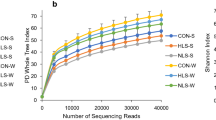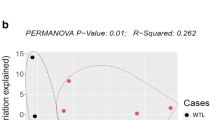Abstract
The effect of a probiotic bacterium on gut function was studied in neonatal animals by using a model with suckling rats. Lactobacillus plantarum 299v (Lp299v) or saline (controls) was fed (3.0 × 106 CFU/g b.wt per day) for one week to rats aged either 3, 7 or 14 days, after which bacterial colonization, gut growth, and functional parameters were analyzed. In rats fed with Lp299v from 3 to 10 days of age, an increase in ceacal lactobacilli was correlated with reduced intestinal macromolecular permeability and increased mucosal protein compared to age-matched controls. Pups treated from 7 to 14 days of age showed a decrease in pancreas weight and protein content, whereas pups treated from 14 to 21 days of age showed little effect of the Lp299v treatment. The results indicated that the bacterial exposure affected the gut function, where the effects were age-related and the youngest rats appeared most sensitive.


Similar content being viewed by others
Abbreviations
- Lp299v:
-
Lactobacillus plantarum 299v
- BIgG:
-
Bovine IgG
- BSA:
-
Bovine serum albumin
- b.wt:
-
Body weight
- CFU:
-
Colony-forming units
References
Walthall K, Cappon GD, Hurtt ME, Zoetis T (2005) Postnatal development of the gastrointestinal system: a species comparison. Birth Defects Res B Dev Reprod Toxicol 74:132–156
Wenzl HH, Schimpl G, Feierl G, Steinwender G (2001) Time course of spontaneous bacterial translocation from gastrointestinal tract and its relationship to intestinal microflora in conventionally reared infant rats. Dig Dis Sci 46:1120–1126
Kaur IP, Chopra K, Saini A (2002) Probiotics: potential pharmaceutical applications. Eur J Pharm Sci 15:1–9
Neish AS (2002) The gut microflora and intestinal epithelial cells: a continuing dialogue. Microbes Infect 4:309–317
Berg R (1996) The indigenous gastrointestinal microflora. Trends Microbiol 4:430–435
Hooper LV, Wong MH, Thelin A, Hansson L, Falk PG, Gordon JI (2001) Molecular analysis of commensal host-microbial relationships in the intestine. Science 291:881–884
Bernardeau M, Vernoux JP, Gueguen M (2002) Safety and efficacy of probiotic lactobacilli in promoting growth in post-weaning Swiss mice. Int J Food Microbiol 77:19–27
Isolauri E, Majamaa H, Arvola T, Rantala I, Virtanen E, Arvilommi E (1993) Lactobacillus casei strain GG reverses increased intestinal permeability induced by cow milk in suckling rats. Gastroenterol 105:1643–1650
Johansson M-L, Molin G, Jeppsson B, Nobaek S, Ahrne´ S, Bengmark S (1993) Administration of different Lactobacillus strains in fermented oatmeal soup: in vivo colonization of human intestinal mucosa and effect on the indigenous flora. Appl Environ Microbiol 59:15–20
Liu Q, Nobaek S, Adawi D, Mao Y, Wang M, Molin G, Ekelund M, Jeppsson B (2001) Administration of Lactobacillus plantarum 299v reduces side-effects of external radiation on colon anastomotic healing in an experimental model. Colorectal Dis 4:245–252
Mangell P, Nejdfors P, Wang M, Ahrne S, Weström B, Thorlacius H, Jeppsson B (2002) Lactobacillus plantarum 299v inhibits Escherichia coli-induced intestinal permeability. Dig Dis Sci 47:511–516
Wang M, Adawi D, Molin G, Pettersson B, Jeppsson B, Ahrne S (2001) Identification of the translocating bacteria in rats with acute liver injury and their relation to the bacterial flora of the intestinal mucosa. APMIS 109:551–558
Dahlqvist A (1984) Assay of intestinal disaccaridases. Scand J Clin Lab Invest 44:169–172
Lowry OH, Rosebrough NJ, Farr AL, Randall RJ (1951) Protein measurements with folin phenol reagent. J Biol Chem 193:256–275
Fritz H, Hartwich G, Werle E (1966) On protease inhibitors. I. Isolation and characterization of trypsin inhibitors from dog pancreas tissue and pancreas secretion. Hoppe Seyler’s Z Physiol Chem 345:150–167
Laurell CB (1972) Electroimmunoassay. Scand J Clin Lab Invest 124:21–37
Herias MV, Hessle C, Telemo E, Midtvedt T, Hanson LÅ, Wold AE (1999) Immunomodulatory effects of Lactobacills plantarum colonizing the intestine of gnotobiotic rats. Clin Exp Immunol 116:283–290
Baken KA, Ezendam J, Gremmer ER, de Klerk A, Pennings JLA, Matthee B, Peijnenburg AACM, van Loveren H (2006) Evaluation of immunomodulation by Lactobacillus casei Shirota: immune function, autoimmunity and gene expression. Int J Food Microbiol 112:8–18
Yang H, Antony PA, Wildhaber BE, Teitelbaum DH (2004) Intestinal intraepithelial lymphocyte γδ-T cell-derived keratinocyte growth factor modulates epithelial growth in the mouse. J Immunol 172:4151–4158
Olah A, Belagyi T, Issekutz A, Gamal ME, Bengmark S (2002) Randomized clinical trial of specific lactobacillus and fibre supplement to early enteral nutrition in patients with acute pancreatitis. Br J Surg 89:1103–1107
Lhoste EF, Catala I, Fiszlewicz M, Gueugneau AM, Popot F, Vaissade P, Corring T, Szylit O (1995) Influence of ceacal microflora and of two dietary protein levels on the adaptation of the exocrine pancreas: comparative study in germ-free and conventional rats. Br J Nutr 75:433–444
Gareau MG, Jury J, MacQueen G, Sherman PM and Perdue MH (2007) Probiotic treatment of rat pups normalizes corticosterone release and ameliorates colonic dysfunction induced by maternal separation. Gut 5 Mar, 2007; DOI: 10.1136/gut.2006.117176
Henning SJ (1987) Functional development of the gastrointestinal tract. In: Johnson LR (ed) Physiology of the gastrointestinal tract, 2nd edn. New York, Raven Press, pp 285–300
Inoue R, Otsuka M, Ushida K (2005) Development of intestinal microbiota in mice and its possible interaction with the evolution of luminal IgA in the intestine. Exp Anim 54:437–445
Kalliomäki M, Salminen S, Arvilommi H, Kero P, Koskinen P, Isolauri E (2001) Probiotics in primary prevention of atopic disease – a randomised, placebo-controlled trial. Lancet 357:1076–1079
Acknowledgements
We wish to thank Mrs. Inger Mattsson for her expert technical assistance in analyzing the blood, intestinal, and pancreatic samples. The Swedish Research Council Formas is also acknowledged for financial support.
Author information
Authors and Affiliations
Corresponding author
Rights and permissions
About this article
Cite this article
Fåk, F., Ahrné, S., Linderoth, A. et al. Age-related Effects of the Probiotic Bacterium Lactobacillus plantarum 299v on Gastrointestinal Function in Suckling Rats. Dig Dis Sci 53, 664–671 (2008). https://doi.org/10.1007/s10620-007-9906-1
Received:
Accepted:
Published:
Issue Date:
DOI: https://doi.org/10.1007/s10620-007-9906-1




